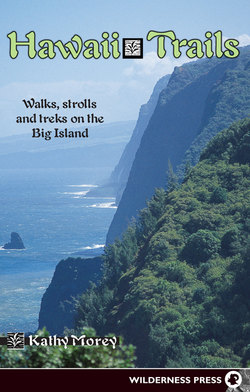Читать книгу Hawaii Trails - Kathy Morey - Страница 7
На сайте Литреса книга снята с продажи.
ОглавлениеIntroduction
Can you name this place? On its west, vast fields of forbidding lava stretch from mountains nearly 14,000 feet high to a coast that’s dotted with shimmering blue bays and luxurious resorts. At its northern end, a remote valley, its steep walls richly clothed in rainforest greenery and streaked by waterfalls, protects a way of life that harkens back to the 1900s. On its east, Earth’s most active volcano destroys famous black-sand beaches and creates new ones just a few miles away. If you jumped into the roiling sea at its desolate southern tip—don’t do it!—you wouldn’t touch land again until you reached Antarctica. What can this contradictory place be? What else but the Big Island of Hawaii!
Some will say you can see the Big Island adequately from the air. Others will say you can drive around it and see everything in a day. Still others would park you in a resort and tell you that’s Hawaii. Don’t believe it! The best of the Big Island is outside, along the trails, where there are no barriers of metal, glass, or concrete to separate you from its lush rainforests, flower-filled parks, steaming volcanoes, and acres of lava “moonscapes.” You don’t have to walk far: a worthwhile hike on Hawaii can be as short as a quarter-mile stroll suitable for anyone who’s ambulatory, or it can be as long as a five-day backpack to the top of its second-highest peak, Mauna Loa.
The shape of things
The Big Island of Hawaii is shaped almost like a square, tipped onto one corner—except that the thumb-shaped Kohala Peninsula juts northwest out of the square. The Big Island is made up of five or six volcanoes (more on this in the section on Geology and History). The island’s center is dominated by the two largest volcanoes: 13,796-foot Mauna Kea, which hasn’t erupted for at least 4,500 years, and 13,679-foot Mauna Loa, which last erupted in 1984, menacing the Big Island’s main city, Hilo. Kilauea volcano on the east is the world’s most active volcano. Its most recent eruption began in 1983 and continues as I write this. Kilauea is the centerpiece of Hawaii Volcanoes National Park, which also includes the summit of Mauna Loa. Hawaii grows each time fresh lava from Kilauea reaches the sea, cools to become new land, and extends the state just a little farther eastward.
Take time for the island of Hawaii
It really is the Big Island! If you have only a day or two on the island of Hawaii, stay put and enjoy what’s nearby. There’s probably a short hike or two in this book that will be very near you. The idea that you can drive around the Big Island and see it all in one day is laughable. Come back for a longer visit when you can.
If possible, stay a week or more on the island of Hawaii. The road that encircles most of the island is over 220 miles long—and it doesn’t get you to the best of the scenery and hiking trails. Give yourself time to move around to different lodgings in order to more fully explore different hiking areas. You could easily spend a month on the island of Hawaii. That’s how big and how spectacular the Big Island is!
Be a good visitor
Along the waterfront in Kailua on the Kona Coast (often called “Kailua-Kona”), the rental cars creep along bumper to bumper. Horns honk. Tourist drivers scream at tourist pedestrians. What the hell kind of tropical paradise is this?! you may think if you’re caught in Kailua-Kona traffic. Where’s that aloha spirit? Fortunately, there are plenty of less crowded, less frantic places on the Big Island.
Still, Hawaii is not Paradise. Paradise is infinite and self-renewing. Hawaii is a real place of finite space and resources, where real people live real lives with jobs, families, budgets, and bills. Hawaii needs loving care from its visitors as well as from its natives. As the number of tourists increases, I think it becomes important that we visitors actively contribute to the aloha spirit instead of just passively expecting to receive it. Bring your best manners and your patience with you to the Big Island. Be the first to smile and wave. Be the first to pull your car over so that someone else can pass. Be scrupulous in observing the rules of the trail in order to help preserve what’s left of Hawaii’s vanishing wild places. NO TRESPASSING, KEEP OUT, or KAPU (“forbidden”) signs mean, “You stay out.” Please respect those signs.
Terms
When I refer to the Hawaiian archipelago in general, and particularly to the inhabited islands, I’ll say “Hawaii.” When I refer to the island of Hawaii itself, I’ll say “the island of Hawaii” or “the Big Island.”
